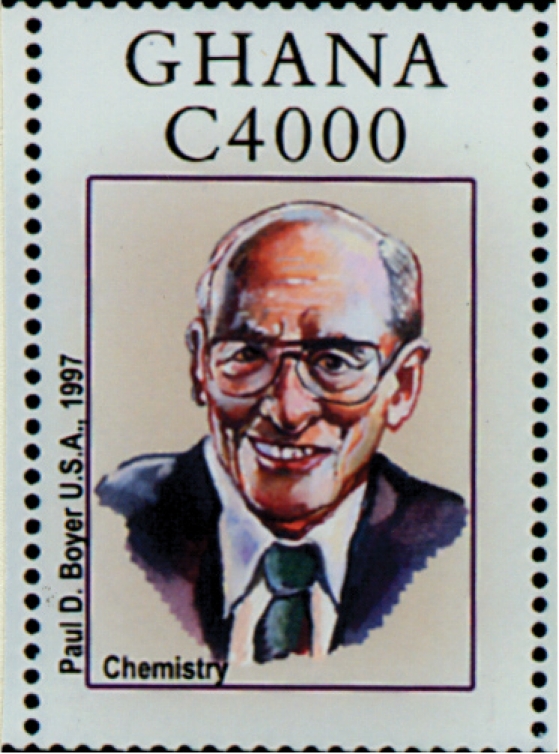
Paul Delos Boyer, American molecular biologist, shared the 1997 Nobel Prize in chemistry with 2 other biochemists, John E. Walker (1941-) of Great Britain and Jens C. Skou (1918-) of Denmark, for their discoveries about ATP synthase, an enzyme responsible for making adenosine triphosphate (ATP), the universal energy carrier in living cells. By means of energy-rich chemical bonds, ATP captures the chemical energy released from food and makes it available to cells for contraction of muscles, transmission of nerve impulses, construction of cell components, and other processes. Boyer worked at the University of California at Los Angeles, Walker at the Medical Research Council Laboratory of Molecular Biology at Cambridge University England, and Skou at Aarhus University (Denmark).
Boyer was born on July 31, 1918, in Provo in north central Utah, about 40 miles southeast of Salt Lake City. His father was an osteopathic physician; Boyer had 5 siblings. His mother died at age 45 years, when Boyer was 15 years old. He attended the public schools of Provo and then entered Brigham Young University. Boyer received the BS degree in 1939. He won a Wisconsin Alumni Research Foundation Scholarship and entered the University of Wisconsin at Madison for graduate work. He was an assistant researcher in biochemistry from 1939 to 1943. Boyer received the MS degree in 1941 and the PhD degree in biochemistry in 1943.
In 1943, Boyer joined the faculty at Stanford University in Palo Alto, CA, where he worked on a war-related research project dedicated to the stabilization of serum albumin for blood transfusions. In 1945, he became an assistant professor at the University of Minnesota in Minneapolis and began independent research.
In 1955-1956, Boyer was a Guggenheim fellow at the university, and from 1956 to 1963, he was a Hill Research Professor at the university’s medical school.
In 1963, Boyer was appointed professor of chemistry at the University of California at Los Angeles (UCLA), where he served as director of the Molecular Biology Institute from 1965 to 1983 and director of the biochemical program from 1983 to 1989. From 1963 to 1989, he was the associate editor or editor of the Annual Review of Biochemistry. In 1990, Boyer became professor emeritus of chemistry and biology at UCLA.
When Boyer began his research on ATP formation in the early 1950s, scientists knew that ATP was the energy carrier in living cells. Adenosine triphosphate consists of a molecule of adenosine linked by high-energy bonds to a chain of 3 phosphate groups. Removal of a phosphate group releases the stored energy for use by cells. In the process, ATP becomes adenosine diphosphate (ADP). With help from chemical energy in food, a phosphate can be added to ADP, producing more ATP. In the late 1970s, Boyer proposed the “binding-change hypothesis,” a detailed elucidation of the mechanism by which ATPase catalyzes the synthesis of ATP from ADP and phosphate.
Besides the Nobel Prize, Boyer has received many honors and awards, including the Rose Award of the American Society of Chemistry and Molecular Biology in 1989 and honorary doctorates from the universities of Stockholm (1974), Minnesota (1996), and Wisconsin (1998). In 2002, Ghana honored Boyer by the issuance of a stamp (Scott No. 2283e).


